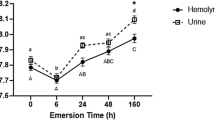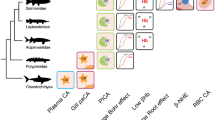Summary
The function of carbonic anhydrase (CA) in the Red Rock Crab,Cancer productus Randall, was investigated. CA activity was found to varying degrees in the gills and many other tissues but not in hemolymph. Crabs injected with acetazolamide, a specific CA inhibitor, demonstrated a significant hemolymph acidosis. Hemolymph CO2 tension (\(Pa_{CO_2 }\)) and CO2 content (\(Ca_{CO_2 }\)) also increased and remained significantly elevated for 96 h following treatment. No significant changes could be detected in either hemolymph oxygenation or ionic status (except for HCO −3 ) as a result of acetazolamide treatment. Crabs treated with acetazolamide, and also exposed to air, exhibited a more pronounced hemolymph acidosis with significantly increased respiratory (\(P_{CO_2 }\)) and metabolic (lactate) components compared with the control group. Upon reimmersion acetazolamide treated crabs showed a slower recovery of hemolymph pH compared with the control group and no significant removal of the total CO2 load induced by air exposure. No significant differences between experimental and control groups during air exposure and recovery could be detected in hemolymph oxygenation, ionic status, NH3+NH +4 levels or respiratory and cardiac pumping frequency and so the effects of acetazolamide treatment were apparently limited to CO2 removal across the gills. These results indicate that branchial CA facilitates the removal of CO2 from the hemolymph of SW adaptedC. productus largely by catalyzing the dehydration of hemolymph HCO −3 to molecular CO2 at the gill. It is also recognized that gill CA may also serve to hydrate molecular CO2 to H+ and HCO3/− for use as counterions for ionic uptake mechanisms. Crab gill CA thus appears to play an important role in CO2 excretion as well as hemolymph ionic regulation.
Similar content being viewed by others
References
Aldridge JB, Cameron JN (1979) CO2 exchange in the blue crab,Callinectes sapidus (Rathbun). J Exp Zool 207:321–328
Ansell AD (1973) Changes in oxygen consumption, heart rate and ventilation accompanying starvation in the decapod crustacean,Cancer pagurus. Neth J Sea Res 17:455–475
Burnett LE (1983) CO2 excretion across isolated perfused crab gills: Facilitation by carbonic anhydrase. Am Zool
Burnett LE, Woodson PBJ, Rietow MG, Vilicich VG (1981) Crab gill intra-epithelial carbonic anhydrase plays a major role in haemolymph CO2 and chloride ion regulation. J Exp Biol 92:243–254
Cameron JN (1971) A rapid method for determination of total carbon dioxide in small blood samples. J Appl Physiol 31:632–634
Davenport HW (1974) The ABC of Acid-Base Chemistry, 6th Edition, The University of Chicago Press, Chicago
de Fur PL, McMahon BR (1984a) Physiological compensation to short term air exposure in red rock crabs,Cancer productus Randall, from littoral and sublittoral habitats. I. Oxygen uptake and transport. Physiol Zool 57:137–150
de Fur PL, McMahon BR (1984b) Physiological compensation to short term air exposure in red rock crabs,Cancer productus Randall, from littoral and sublittoral habitats. II. Acidbase balance. Physiol Zool 57:151–160
de Fur PL, Wilkes PRH, McMahon BR (1980) Non-equilibrium acid-base status inC. productus: Role of exoskeletal carbonate buffers. Respir Physiol 42:247–261
Ehrenfeld J (1974) Aspects of ionic transport mechanisms in crayfishAstacus leptodactylus. J Exp Biol 61:57–70
Effros RM, Chang RSY, Silverman P (1978) Acceleration of plasma bicarbonate conversion to carbon dioxide by pulmonary carbonic anhydrase. Science 199:427–429
Effros RM, Shapiro L, Silverman P (1980) Carbonic anhydrase activity of rabbit lungs. J Appl Physiol 49:589–600
Ferguson JKW, Lewis L, Smith J (1937) The distribution of carbonic anhydrase in certain marine invertebrates. J Cell Comp Physiol 10:395–400
Giraud M-M (1981) Carbonic anhydrase activity in the integument of the crabCarcinus maenas during the intermolt cycle. Comp Biochem Physiol 69A:381–387
Gleeson RA, Zubkoff RL (1977) The determination of hemolymph volume in the blue crab,Callinectes sapidus utilizing14C-thiocyanate. Comp Biochem Physiol 56A:411–413
Gutknecht J, Bisson MA, Tosteson FC (1977) Diffusion of carbon dioxide through lipid bilayer membranes. J Gen Physiol 69:779–794
Haswell MS, Randall DJ (1978) The pattern of carbon dioxide excretion in the rainbow troutSalmo gairdneri. J Exp Biol 72:17–24
Henry RP, Cameron JN (1982) The distribution and partial characterization of carbonic anhydrase in selected aquatic and terrestrial decapod crustaceans. J Exp Zool 221:309–321
Henry RP, Cameron JN (1983) The role of carbonic anhydrase in respiration, ion regulation and acid-base balance in the aquatic crabCallinectes sapidus and the terrestrialGecarcinus lateralis. J Exp Biol 103:205–223
Hunter KC, Rudy PP (1975) Osmotic and ionic regulation in the Dungeness crab,Cancer magister Dana. Comp Biochem Physiol 51A:439–447
Klocke RA (1978) Catalysis of CO2 reactions by lung carbonic anhydrase. J Appl Physiol 44:882–888
Lonnerholm G (1982) Pulmonary carbonic anhydrase in the human, monkey, and rat. J Appl Physiol 52:352–356
Maren T (1967) Carbonic anhydrase: Chemistry, physiology, and inhibition. Physiol Rev 47:595–781
McDonald DG (1977) Respiratory physiology of the crabCancer magister. PhD thesis, University of Calgary, Calgary, Alberta
McMahon BR, Wilkens JL (1977) Periodic respiratory and circulatory performance in the red rock crabCancer productus. J Exp Zool 202:363–374
McMahon BR, Burnett LE (1981) Acid-base balance and CO2 excretion in two littoral crabsHemigrapsus nudus andPachygrapsus crassipes. Am Zool 21:1014
McMahon BR, Wilkens JL (1983) Ventilation, perfusion and oxygen uptake. In: Mantell L (ed) Biology of Crustacea, vol 5. Academic Press, New York, pp 289–312
McMahon BR, Butler PJ, Taylor EW (1978) Acid-base changes during recovery from disturbance and during long term hypoxic exposure in the lobsterHomarus vulgaris. J Exp Zool 205:361–370
McMahon BR, Burnett LE, de Fur PL (1982) Effects of acetazolamide on branchial CO2 excretion in the marine crabCancer productus. Physiologist 25:235
Pearson J (1908) Cancer. Liv Mar Biol Comm Memoirs, vol 16
Randall DJ, Wood CM (1981) Carbon dioxide excretion in the land crab (Cardisoma carnifex). J Exp Zool 218:37–44
Roughton FJW (1970) Some recent work on the interactions of oxygen, carbon dioxide and haemoglobin. Biochem J 117:801–812
Roughton FJW, Rossi-Bernardi L (1966) The carbamate reaction of carbon dioxide with glycyl-glycine. Proc R Soc London Ser B 164:381–400
Ryan VS, Whitney PL, Ryan JW (1982) Localization of carbonic anhydrase on pulmonary artery endothelial cells in culture. J Appl Physiol 53:914–919
Solorzano L (1969) Determination of ammonia in natural water by the phenolhypochlorite method. Limnol Oceanogr 14:799–801
Truchot J-P (1975a) Blood acid-base changes during experimental emersion and reimmersion of the intertidal crabCarcinus maenas (L). Respir Physiol 23:351–360
Truchot J-P (1975b) Action de l'hypercapnie sur l'état acidebase du sang chez le crabeCarcinus maenas (L) (Crustacé Décapode). C R Acad Sci Paris 280:311–314
Truchot J-P (1976) Carbon dioxide combining properties of the blood of the shore crabCarcinus maenas (L): CO2 dissociation curve and Haldane effect. J Comp Physiol 112:283–293
Truchot J-P (1978) Mechanisms of extracellular acid-base regulation as temperature changes in decapod crustaceans. Respir Physiol 33:161–176
van Goor H (1937) La repartition de l'anhydrase carbonique dans l'organisme des animaux. Arch Int Physiol 45:491–509
van Goor H (1940) Die Verbreitung und Bedeutung der Carbonanhydrase. Enzymol 8:113–128
Wilkes PRH, McMahon BR (1982) Effect of maintained hypoxic exposure in the crayfishOrconectes rusticus: II. Modulation of haemocyanin oxygen affinity. J Exp Biol 98:139–150
Wood CM, Randall DJ (1981) Haemolymph gas transport, acid-base regulation, and anaerobic metabolism during exercise in the land crab (Cardisoma carnifex). J Exp Zool 218:23–35
Wood CM, McDonald DG, McMahon BR (1982) The influence of experimental anaemia on blood acid-base regulationin vivo andin vitro in the starry flounder (Platichthys stellatus) and the rainbow trout (Salmo gairdneri). J Exp Biol 96:221–238
Author information
Authors and Affiliations
Rights and permissions
About this article
Cite this article
McMahon, B.R., Burnett, L.E. & de Fur, P.L. Carbon dioxide excretion and carbonic anhydrase function in the Red Rock CrabCancer productus . J Comp Physiol B 154, 371–383 (1984). https://doi.org/10.1007/BF00684444
Accepted:
Issue Date:
DOI: https://doi.org/10.1007/BF00684444




